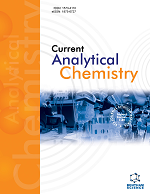- Home
- A-Z Publications
- Current Analytical Chemistry
- Previous Issues
- Volume 1, Issue 1, 2005
Current Analytical Chemistry - Volume 1, Issue 1, 2005
Volume 1, Issue 1, 2005
-
-
Editorial
More LessThis inaugural issue of Current Analytical Chemistry comprises a number of important reviews on the use of NMR spectroscopy for study of supra- and biomolecular systems, advances in head space gas chromatography, recent developments in chromatographic enantioseparations, ligand-exchange chromatography of amino acids, mass spectroscopic techniques for analysis of glycoproteins and glycans, open tubular electr Read More
-
-
-
Merging Concepts from Liquid-State and Solid-State NMR Spectroscopy for the Investigation of Supra- and Biomolecular Systems
More LessBy Ingo SchnellAfter the fields of liquid- and solid-state NMR spectroscopy have developed largely independently of each other over the past 50 years, materials of current interest call for new approaches which combine and merge spectroscopic techniques from either side. A particular possibility to promote NMR spectroscopy into this direction is provided by magic-angle sample spinning (MAS), which can be performed either at high speeds i Read More
-
-
-
The Mass Spectrometric Analysis of Glycoproteins and their Glycan Structures
More LessAuthors: Willy Morelle and Jean-Claude MichalskiOne of the most common post-translational modifications of proteins involves the covalent attachment of N- or O-linked carbohydrates to the protein. Glycan moieties are involved in a wide variety of intracellular, cell-cell and cell-matrix recognition events. The study of glycoprotein-linked carbohydrates remains one of the most challenging tasks given to biochemists and bioanalysts as these molecules can exhibit complex Read More
-
-
-
What's New in Chromatographic Enantioseparations
More LessAuthors: Jacek Bojarski, Hassan Y. Aboul-Enein and Ashraf GhanemProgress in different areas of enantioselective chromatography and its applications in last years (2002-2003) is reviewed. Special attention is devoted to chromatographic enantioseparations of different drugs and natural compounds.
-
-
-
Some Recent Developments in Headspace Gas Chromatography
More LessAuthors: J. Y. Zhu and X.- S. ChaiIn this study, recent developments in headspace gas chromatography (HSGC) are briefly reviewed. Several novel HSGC techniques developed recently are presented in detail. These techniques were developed using the unique characteristics of the headspace sampling process implemented in commercial HSGC systems and therefore can be easily applied in laboratory and industrial practices. These techniques Read More
-
-
-
O-Benzyl-(S)-Serine, a New Chiral Selector for Ligand-Exchange Chromatography of Amino Acids
More LessAuthors: Benedetto Natalini, Roccaldo Sardella and Roberto PellicciariO-Benzyl-(S)-serine is a new selector for chiral ligand-exchange chromatography which has proved to be effective in the analytical separation of some natural and unnatural underivatized amino acids with fair to good separation and resolution factors. Both chiral mobile phase (CMP) and hydrophobically coated chiral stationary phase (CSP) approaches were successfully employed. A not completely clarified mechanism of Read More
-
-
-
Reliability of Carotenoid Analyses: A Review
More LessAuthors: Ladislav Feltl, Vera Pacakova, Karel Stulik and Karel VolkaThis review critically discusses the most important properties of techniques applied to analyses for carotenoids and their impact on the reliability of the analytical results. The emphasis is placed on modern methods and the most recent references. Examples of analytical procedures illustrate the characteristics of experimental approaches to carotenoid analyses but no systematic survey of applications is given. Carotenoids are ch Read More
-
-
-
Porphyrin Based Affinity Interactions: Analytical Applications with Special Reference to Open Tubular Capillary Electrochromatography
More LessAuthors: Zdenek Deyl, Ivan Miksik, Adam Eckhardt, Vaclav Kasicka and Vladimir KralThis review offers a brief summary of results obtained from separations of the sets of biologically relevant compounds (carboxylic acids, amino acids, peptides, nucleotides and organic phosphates) using open tubular capillary electrochromatography (OT-CEC), in which oligopyrrolic macrocycles serve as the modifiers of the inner fused silica capillary wall surface. Types of interactions leading to improved selectivity of Read More
-
Volumes & issues
-
Volume 21 (2025)
-
Volume 20 (2024)
-
Volume 19 (2023)
-
Volume 18 (2022)
-
Volume 17 (2021)
-
Volume 16 (2020)
-
Volume 15 (2019)
-
Volume 14 (2018)
-
Volume 13 (2017)
-
Volume 12 (2016)
-
Volume 11 (2015)
-
Volume 10 (2014)
-
Volume 9 (2013)
-
Volume 8 (2012)
-
Volume 7 (2011)
-
Volume 6 (2010)
-
Volume 5 (2009)
-
Volume 4 (2008)
-
Volume 3 (2007)
-
Volume 2 (2006)
-
Volume 1 (2005)
Most Read This Month
Article
content/journals/cac
Journal
10
5
false
en


